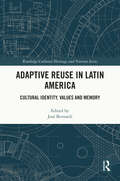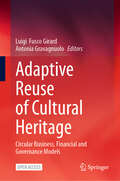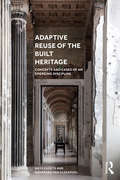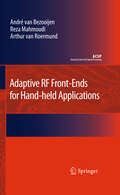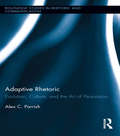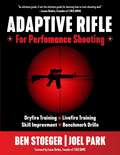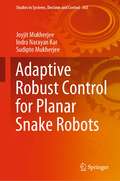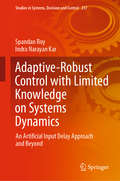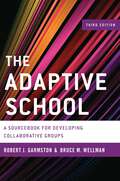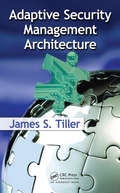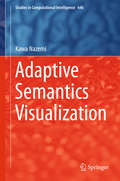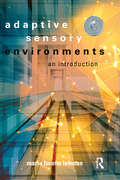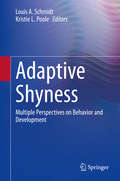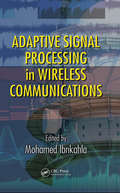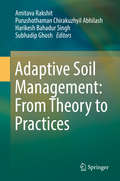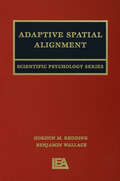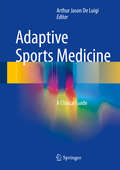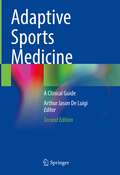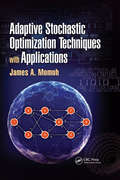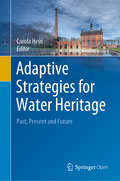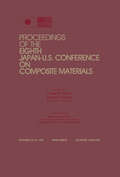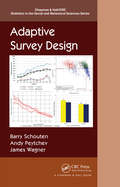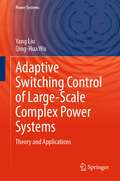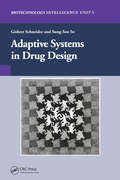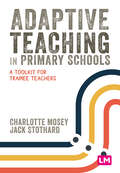- Table View
- List View
Adaptive Reuse in Latin America: Cultural Identity, Values and Memory (Routledge Cultural Heritage and Tourism Series)
by José BernardiThis book seeks to explore the theoretical and architectural connections between memory, values, cultural identity, and adaptive reuse in Latin America. It does so by critically analyzing ideas and works within the context from where they emerge. With rich and layered historic centers, a wealth of colonial and 19th-century buildings, and the heritage from the modern era, Latin America offers a unique architectural patrimony and its contribution and impact on contemporary culture and architecture still require critical study and discussion. The chapters of this timely book consider the conflicted relationship between colonialism, native cultures, and immigration. It also explores the connections between modern projects and national identity, and contemporary interventions serving the needs of diverse societies while being cultural receptacles of memory. While most books on adaptive reuse focus on the larger general concepts, different technical approaches, and case studies, this book will contribute to the study of adaptive reuse moving away from Europe and North America, focusing instead on cases in Brazil, Mexico, Argentina, Ecuador, and Peru. This book is an important resource for researchers and students in the area of architecture, cultural, global, and design studies, heritage, geography, sociology, and history.
Adaptive Reuse of Cultural Heritage: Circular Business, Financial and Governance Models
by Luigi Fusco Girard Antonia GravagnuoloThis open access book addresses the gap in existing knowledge on cultural heritage from a circular economy and sustainable development perspective for cities. It introduces innovative economic, environmental and governance models and evaluation tools tested and validated for adaptive reuse within the “CLIC - Circular models Leveraging Investments in Cultural Heritage Adaptive Reuse” project funded by the European Horizon 2020 Research & Innovation Action Program. The CLIC project is a trans-disciplinary research project bringing together expertise from disciplines such as heritage studies, regeneration and urban development, business management, economics, ecology and social sciences. The research covered in this book, responds to the European Societal Challenge 5 'Climate action, environment, resource efficiency and raw materials', aimed at achieving resource efficient and climate change resilient economy and society through systemic innovation. The CLIC project also unlocks public and private investments in solutions for a more resource efficient, greener and more competitive economy as a key part of smart, inclusive and sustainable growth strategy for Europe and worldwide. This book is fundamental key reading for scholars, professionals and policy makers, demonstrating how the adaptive reuse of cultural heritage, in a systemic perspective, has the potential to stimulate growth, sustainable development, social regeneration, welfare, jobs, income, and livability of urban / territorial settings: to implement the circular economy model. It also provides innovative models and a circular toolkit for financing, reusing and managing cultural heritage based on research outcomes and implementation of experimental models in four pilot European territories covered as case studies.
Adaptive Reuse of the Built Heritage: Concepts and Cases of an Emerging Discipline
by Bie Plevoets Koenraad Van CleempoelAdaptive reuse – the process of repairing and restoring existing buildings for new or continued use – is becoming an essential part of architectural practice. As mounting demographic, economic, and ecological challenges limit opportunities for new construction, architects increasingly focus on transforming and adapting existing buildings. This book introduces adaptive reuse as a new discipline. It provides students and professionals with the understanding and the tools they need to develop innovative and creative approaches, helping them to rethink and redesign existing buildings – a skill which is becoming more and more important. Part I outlines the history of adaptive reuse and explains the concepts and methods that lie behind new design processes and contemporary practice. Part II consists of a wide range of case studies, representing different time periods and strategies for intervention. Iconic adaptive reuse projects such as the Caixa Forum in Madrid and the Rijksmuseum in Amsterdam are discussed alongside less famous and spontaneous transformations such as the Kunsthaus Tacheles in Berlin, in addition to projects from Italy, Spain, Croatia, Belgium, Poland, and the USA. Featuring over 100 high-quality color illustrations, Adaptive Reuse of the Built Heritage is essential reading for students and professionals in architecture, interior design, heritage conservation, and urban planning.
Adaptive RF Front-Ends for Hand-held Applications (Analog Circuits and Signal Processing)
by Reza Mahmoudi Arthur H.M. van Roermund Andre Van BezooijenThe RF front-end - antenna combination is a vital part of a mobile phone because its performance is very relevant to the link quality between hand-set and cellular network base-stations. The RF front-end performance suffers from changes in operating environment, like hand-effects, that are often unpredictable. Adaptive RF Front-Ends for Hand-Held Applications presents an analysis on the impact of fluctuating environmental parameters. In order to overcome undesired behavior two different adaptive control methods are treated that make RF frond-ends more resilient: adaptive impedance control, and adaptive power control. Several adaptive impedance control techniques are discussed, using a priori knowledge on matching network properties, in order to simplify robust 2-dimensional control. A generic protection concept is presented, based on adaptive power control, which improves the ruggedness of a power amplifier or preserves its linearity under extremes. It comprises over-voltage, over-temperature, and under-voltage protection.
Adaptive Rhetoric: Evolution, Culture, and the Art of Persuasion (Routledge Studies in Rhetoric and Communication)
by Alex C. ParrishRhetorical scholarship has for decades relied solely on culture to explain persuasive behavior. While this focus allows for deep explorations of historical circumstance, it neglects the powerful effects of biology on rhetorical behavior – how our bodies and brains help shape and constrain rhetorical acts. Not only is the cultural model incomplete, but it tacitly endorses the fallacy of human exceptionalism. By introducing evolutionary biology into the study of rhetoric, this book serves as a model of a biocultural paradigm. Being mindful of biological and cultural influences allows for a deeper view of rhetoric, one that is aware of the ubiquity of persuasive behavior in nature. Human and nonhuman animals, and even some plants, persuade to survive - to live, love, and cooperate. That this broad spectrum of rhetorical behavior exists in the animal world demonstrates how much we can learn from evolutionary biology. By incorporating scholarship on animal signaling into the study of rhetoric, the author explores how communication has evolved, and how numerous different species of animals employ similar persuasive tactics in order to overcome similar problems. This cross-species study of rhetoric allows us to trace the origins of our own persuasive behaviors, providing us with a deeper history of rhetoric that transcends the written and the televised, and reveals the artifacts of our communicative past.
Adaptive Rifle: For Performance Shooting
by Ben Stoeger Joel ParkElevate Your Rifle Skills with Adaptive Rifle Join World Champion shooter and esteemed instructor Ben Stoeger alongside Joel Park as they unveil their groundbreaking approach to carbine training. The material in Adaptive Rifle represents the cutting edge of rifle training for civilians, law enforcement, and military shooters. Whether you're a novice exploring the world of shooting or a seasoned professional honing your skills, Adaptive Rifle is your indispensable guide to mastering modern training methods and cutting-edge techniques. Prepare to elevate your shooting prowess and embrace the future of rifle training with Adaptive Rifle.
Adaptive Robust Control for Planar Snake Robots (Studies in Systems, Decision and Control #363)
by Joyjit Mukherjee Indra Narayan Kar Sudipto MukherjeeThis book shows how a conventional multi-layered approach can be used to control a snake robot on a desired path while moving on a flat surface. To achieve robustness to unknown variations in surface conditions, it explores various adaptive robust control methods.The authors propose a sliding-mode control approach designed to achieve robust maneuvering for bounded uncertainty with a known upper bound. The control is modified by addition of an adaptation law to alleviate the overestimation problem of the switching gain as well as to circumvent the requirement for knowledge regarding the bounds of uncertainty. The book works toward non-conservativeness, achieving efficient tracking in the presence of slowly varying uncertainties with a specially designed framework for time-delayed control. It shows readers how to extract superior performance from their snake robots with an approach that allows robustness toward bounded time-delayed estimation errors. The book also demonstrates how the multi-layered control framework can be simplified by employing differential flatness for such a system. Finally, the mathematical model of a snake robot moving inside a uniform channel using only side-wall contact is discussed. The model has further been employed to demonstrate adaptive robust control design for such a motion.Using numerous illustrations and tables, Adaptive Robust Control for Planar Snake Robots will interest researchers, practicing engineers and postgraduate students working in the field of robotics and control systems.
Adaptive-Robust Control with Limited Knowledge on Systems Dynamics: An Artificial Input Delay Approach and Beyond (Studies in Systems, Decision and Control #257)
by Spandan Roy Indra Narayan KarThe book investigates the role of artificial input delay in approximating unknown system dynamics, referred to as time-delayed control (TDC), and provides novel solutions to current design issues in TDC. Its central focus is on designing adaptive-switching gain-based robust control (ARC) for a class of Euler–Lagrange (EL) systems with minimal or no knowledge of the system dynamics parameters. The newly proposed TDC-based ARC tackles the commonly observed over- and under-estimation issues in switching gain. The consideration of EL systems lends a practical perspective on the proposed methods, and each chapter is supplemented by relevant experimental data. The book offers a unique resource for researchers in the areas of ARC and TDC alike, and covers the state of the art, new algorithms, and future directions.
The Adaptive School: A Sourcebook For Developing Collaborative Groups (Christopher-gordon New Editions Ser.)
by Robert J. Garmston Bruce M. WellmanThis 3rd edition of the award winning Adaptive Schools Sourcebook provides both a theoretical and practical guide for groups and teams to develop and focus their collaborative energies to improve teaching practices and enhance student-learning outcomes. In five sections: Becoming Adaptive, Collaboration Matters, Meetings are Teachers’ Work, Resources for Inquiry, and Conflict, Change and Community, the authors draw on decades of personal experiences in schools and research from multiple disciplines to present powerful tools and useful templates for structuring the work of productive professional communities in schools. Readers will learn ways to develop and sustain the fundamental elements for enhancing social capital in schools: distinguishing between dialogue and discussion, establishing seven norms of collaboration, automating language patterns for inquiry and problem solving, facilitating groups and data teams, engaging in productive conflict, and building community. The book offers links to video clips demonstrating key skills, inventories for assessing groups, instruments for assessing personal skills, and a collection of over 150 meeting strategies and facilitator moves for engaging group members in productive interactions.
Adaptive Security Management Architecture
by James S. TillerThis volume enables security professionals to structure the best security program designed to meet the complex needs of an entire organization, taking into account the organization's business goals as well as the surrounding controls, processes, and units already in existence. The book explains how an organization can develop an adaptive security program closely aligned to business needs, making it an enabling force that helps the organization achieve its goals and objectives. It presents the end product of a successful security management system and examines the finer points of how it can be accomplished.
Adaptive Semantics Visualization (Studies in Computational Intelligence #646)
by Kawa NazemiThis bookintroduces a novel approach for intelligent visualizations that adapts thedifferent visual variables and data processing to human's behavior and giventasks. Thereby a number of new algorithms and methods are introduced to satisfythe human need of information and knowledge and enable a usable and attractiveway of information acquisition. Each method and algorithm is illustrated in areplicable way to enable the reproduction of the entire "SemaVis" system orparts of it. The introduced evaluation is scientifically well-designed andperformed with more than enough participants to validate the benefits of themethods. Beside the introduced new approaches and algorithms, readers may finda sophisticated literature review in Information Visualization and VisualAnalytics, Semantics and information extraction, and intelligent and adaptivesystems. This book is based on an awarded and distinguished doctoral thesis incomputer science.
Adaptive Sensory Environments: An Introduction
by Maria Lorena Lehman***WINNER OF A NAUTILUS 2017 SILVER MEDAL BOOK AWARD*** Adaptive Sensory Environments: An Introduction presents a cutting-edge methodology for adaptive sensory design by fostering an inter-disciplinary approach in which aspects of neuroscience, biophilia, captology, nanotechnology, kinetics, and sensemaking all play critical roles in helping adaptive architecture "tune" to occupants. Furthermore, the book illustrates how adaptive sensory environments transform and uplift quality of life in entirely new ways, by strategically unlocking the potential that technological innovations bring. By teaching scholars, researchers, practitioners, specialists, and consultants how to design architecture that guides what emerging interactive technology can do, it allows them to see deeper into an architectural design, to extend beyond interaction and, ultimately, to build environments that adapt by changing and growing with their occupants’ immediate needs and long-term goals.
Adaptive Shyness: Multiple Perspectives on Behavior and Development
by Louis A. Schmidt Kristie L. PooleThis book examines the adaptive aspects of shyness. It addresses shyness as a ubiquitous phenomenon that reflects a preoccupation of the self in response to social interaction, resulting in social inhibition, social anxiety, and social withdrawal. The volume reviews the ways in which shyness has traditionally been conceptualized and describes the movement away from considering it as a disorder in need of treatment. In addition, it examines the often overlooked history and current evidence across evolution, animal species, and human culture, demonstrating the adaptive aspects of shyness from six perspectives: developmental, biological, social, cultural, comparative, and evolutionary. Topics featured in this book include:The study of behavioral inhibition and shyness across four academic generations.The development of adaptive subtypes of shyness.Shy children’s adaptation to academic challenges.Adaptiveness of introverts in the workplace.The role of cultural norms and values in shaping shyness.Perspectives of shyness as adaptive from Indigenous Peoples of North America.The role that personality differences play on ecology and evolution. Adaptive Shyness is a must-have resource for researchers and professors, clinicians and related professionals as well as graduate students in developmental psychology, pediatrics, and social work as well as related disciplines, including social/personality, evolutionary, biological, and clinical child psychology, anthropology, sociology, and cultural studies.
Adaptive Signal Processing in Wireless Communications
by Mohamed IbnkahlaAdaptive techniques play a key role in modern wireless communication systems. The concept of adaptation is emphasized in the Adaptation in Wireless Communications Series through a unified framework across all layers of the wireless protocol stack ranging from the physical layer to the application layer, and from cellular systems to next-generation wireless networks. This specific volume, Adaptive Signal Processing in Wireless Communications is devoted to adaptation in the physical layer. It gives an in-depth survey of adaptive signal processing techniques used in current and future generations of wireless communication systems. Featuring the work of leading international experts, it covers adaptive channel modeling, identification and equalization, adaptive modulation and coding, adaptive multiple-input-multiple-output (MIMO) systems, and cooperative diversity. It also addresses other important aspects of adaptation in wireless communications such as hardware implementation, reconfigurable processing, and cognitive radio. A second volume in the series, Adaptation and Cross-layer Design in Wireless Networks(cat no.46039) is devoted to adaptation in the data link, network, and application layers.
Adaptive Soil Management: From Theory to Practices
by Harikesh Bahadur Singh Amitava Rakshit Purushothaman Chirakuzhyil Abhilash Subhadip GhoshThe book focuses in detail on learning and adapting through partnerships between managers, scientists, and other stake#65533;holders who learn together how to create and maintain sustainable resource systems. As natural areas shrink and fragment, our ability to sustain economic growth and safeguard biological diversity and ecological integrity is increasingly being put to the test. In attempting to meet this unprecedented challenge, adaptive management is becoming a viable alternative for broader application. Adaptive management is an iterative decision-making process which is both operationally and conceptually simple and which incorporates users to acknowledge and account for uncertainty, and sustain an operating environment that promotes its reduction through careful planning, evaluation, and learning until the desired results are achieved. This multifaceted approach requires clearly defined management objectives to guide decisions about what actions to take, and explicit assumptions about expected outcomes to compare against actual outcomes. In this edited book, we address the issue by pursuing a holistic and systematic approach that utilizes natural resources to reap sustainable environmental, economic and social benefits for adap#65533;tive management, helping to ensure that relationships between land, water and plants are managed in ways that mimic nature.
Adaptive Spatial Alignment (Scientific Psychology Series)
by Benjamin Wallace Gordon M. ReddingFor most people, prism adaptation is an amusing demonstration, first experienced perhaps in an introductory psychology course. This monograph relates this peculiar phenomenon to the larger context of cognitive science, especially motor control and learning. The first part sketches the background concepts necessary to understand the contribution of prism adaptation to the larger issue of adaptive perceptual-motor performance including: * a review of the basic concepts of motor control and learning that enable strategic response in the prism adaptation situation; * the development of a hypothesis about spatial representation and spatial mapping and an introduction to the basic idea of adaptive spatial alignment; and * a contrasting view of perceptual and motor learning and a review of evidence for the involvement of nonassociative and associative learning in prism adaptation. Directly concerned with data and theory in prism adaptation, the second part presents: * an outline of prism adaptation methodology and a list of several empirical conclusions from previous research that constrained development of theoretical framework; * a theory of strategic perceptual-motor control and learning which enables adaptive performance during prism exposure, but does not directly involve adaptive spatial alignment; * an extention of the theory to include realignment processes which correct for the spatial misalignment among sensorimotor systems produced by prisms; and * a demonstration of how traditional issues in prism adaptation may be rephrased in terms of the present theoretical framework. The last part of this volume reviews the research conducted in developing and testing the present theory of prism adaptation. It summarizes the initial investigations (employing a naturalistic exposure setting), reports some more rigorous tests with an experimentally constrained research paradigm, points out the more general theoretical issues raised by the authors' analysis of prism adaptation, and makes specific suggestions for further research within the prism adaptation paradigm.
Adaptive Sports Medicine: A Clinical Guide
by Arthur Jason De LuigiThis first-of-its-kind text provides a comprehensive presentation and review of the unique aspects of adaptive sports medicine and adaptive athletes, who are increasingly active and prominent, not only individually and in local leagues and organizations but also in larger settings like the Paralympics. Divided into thematic sections, part one covers the history and natural course of the care, policies and laws that have been developed over the years for persons with disabilities, as well as the biomechanics and technology of wheelchair sports and adaptive sports prostheses. The medical considerations of the adaptive athlete comprise part two, including injury epidemiology, emergent care, and surgical and rehabilitative considerations. Part three, by far the most extensive section, discusses specific wheelchair and adaptive sports, including adaptive running, cycling, water sports and throwing sports, wheelchair basketball, softball and rugby, as well as adaptive combative and extreme sports. Selected topics, including event planning, advocacy and controversies such as doping, are covered in part four. A comprehensive yet practical text, Adaptive Sports Medicine is a go-to resource and will be an invaluable reference for any sports medicine or primary medicine practitioner working with this unique population.
Adaptive Sports Medicine: A Clinical Guide
by Arthur Jason De LuigiNow in a revised and expanded second edition, this unique book provides a comprehensive review of the unique aspects of adaptive sports medicine and adaptive athletes who are increasingly active and prominent, not only individually and in local leagues and organizations but also in larger settings like the Paralympics and Warrior Games.This book is divided into four thematic sections. Section one covers the history and natural course of the care, policies, and laws for persons with disabilities, as well as the biomechanics and technology of wheelchair sports and adaptive sports prostheses. The medical considerations of the adaptive athlete comprise section two, including epidemiology, emergent care, and surgical and rehabilitative considerations. Section three is the largest section, discussing considerations for specific adaptive sports, including adaptive running, cycling, water sports, throwing sports, wheelchair basketball, softball and rugby, as well as combative and extreme sports. Selected topics, including event planning, advocacy and controversies such as doping, are covered in section four. Chapters new to this edition include approaches to concussions and sports-related considerations for specific populations like children and adolescents, active duty military and veterans. A comprehensive yet practical text, Adaptive Sports Medicine 2nd Edition remains the go-to resource for this active population and is an invaluable reference for any sports medicine or primary medicine practitioner.
Adaptive Stochastic Optimization Techniques with Applications
by James A. MomohAdaptive Stochastic Optimization Techniques with Applications provides a single, convenient source for state-of-the-art information on optimization techniques used to solve problems with adaptive, dynamic, and stochastic features. Presenting modern advances in static and dynamic optimization, decision analysis, intelligent systems, evolutionary pro
Adaptive Strategies for Water Heritage: Past, Present and Future
by Carola HeinThis Open Access book, building on research initiated by scholars from the Leiden-Delft-Erasmus Centre for Global Heritage and Development (CHGD) and ICOMOS Netherlands, presents multidisciplinary research that connects water to heritage. Through twenty-one chapters it explores landscapes, cities, engineering structures and buildings from around the world. It describes how people have actively shaped the course, form and function of water for human settlement and the development of civilizations, establishing socio-economic structures, policies and cultures; a rich world of narratives, laws and practices; and an extensive network of infrastructure, buildings and urban form. The book is organized in five thematic sections that link practices of the past to the design of the present and visions of the future: part I discusses drinking water management; part II addresses water use in agriculture; part III explores water management for land reclamation and defense; part IV examines river and coastal planning; and part V focuses on port cities and waterfront regeneration. Today, the many complex systems of the past are necessarily the basis for new systems that both preserve the past and manage water today: policy makers and designers can work together to recognize and build on the traditional knowledge and skills that old structure embody. This book argues that there is a need for a common agenda and an integrated policy that addresses the preservation, transformation and adaptive reuse of historic water-related structures. Throughout, it imagines how such efforts will help us develop sustainable futures for cities, landscapes and bodies of water.
Adaptive Structures, Eighth Japan/US Conference Proceedings
by Golam M. NewazFirst published in 1998. A collection of papers presented at the Proceedings of the Eighth Japan-U.S. Conference On Composite Materials, SEPTEMBER 24 to 25 , 1998. The conference is organized by Wayne State University and American Society for Composites in cooperation with U.S. Organizing Committee and the Japanese Organizing Committee. Since the Seventh Meeting in Kyoto in 1995, this meeting brings together accomplished composite researchers between the two countries to share latest developments and advances in the field. The scope of the current conference ranges over all aspects of composite materials with some emphasis on infrastructure applications of composites. Key areas in composites are covered by 110 papers with 35 presentations from Japan.
Adaptive Survey Design (Chapman & Hall/CRC Statistics in the Social and Behavioral Sciences)
by Barry Schouten Andy Peytchev James WagnerAdaptive survey designs (ASDs) provide a framework for data-driven tailoring of data collection procedures to different sample members, often for cost and bias reduction. People vary in how likely they are to respond and in how they respond. This variation leads to opportunities to selectively deploy design features in order to control both nonresponse and measurement errors. ASD aims at the optimal matching of design features and the characteristics of respondents given the survey budget. Such a goal is sensible, but ASD requires investment in more advanced technical systems and management infrastructure and asks for the collection of relevant auxiliary data. So what are current best practices in ASD? And is ASD worthwhile when the same auxiliary data are employed in the estimation afterwards? In this book, the authors provide answers to these questions, and much more.
Adaptive Switching Control of Large-Scale Complex Power Systems: Theory and Applications (Power Systems)
by Yang Liu Qing-Hua WuThis book presents the latest research on switching control, adaptive switching control, and their applications in the transient stability control and analysis of large-scale complex power systems. In large-scale complex power systems, renewable power generators, flexible power electronics converters, and distributed controllers are widely employed. Due to the poor overcurrent tolerance capability of power electronics converters and lacking of coordination mechanism, stability control in events, such as natural disasters, cascaded faults, and severe disturbances, is viewed as the key challenge in the operation of these systems. High-performance self-coordinated controllers are needed for the control of important power sources and power electronics converters. Adaptive switching controllers are a group of controllers designed by the authors for the control of various renewable power generators, synchronous generators, and modular multilevel converters. These controllers operate in a self-coordinated manner and aim to employ the largest transient control energy of converters and power sources. Imbalance between power generation and consumption is largely filled by the application of these controllers, and transient stability of power systems can be significantly improved. This book covers both the preliminary knowledge and key proofs in the design and stability analysis of adaptive switching control systems, and considerable simulation and experimental results are presented to illustrate the application and performance of the controllers. This book is used as a reference book for researchers and engineers in fields of electrical engineering and control engineering.
Adaptive Systems in Drug Design
by Gisbert Schneider Sung-Sau SoA brief history of drug design presented to make clear that there are fashions in this important field and that they change rather rapidly. This is due in part to the fact that the way that a new paradigm is accepted in a drug company often does not depend on its scientific merit alone.
Adaptive Teaching in Primary Schools: A toolkit for trainee teachers (Primary Teaching Now)
by Charlotte Mosey Jack StothardA guide for trainee and beginning teachers on Adaptive Teaching. This book explores what we mean by ′Adaptive Teaching′ and considers this in the current context of schools and teaching in the UK. It includes key theory to support trainee teachers′ foundation knowledge. Importantly, the text focuses on practical support for classroom teaching and includes suggested approaches and examples of good practice to learn from and adapt. ′How to′ guidance supporting trainees on placements and in their first years of teaching.
